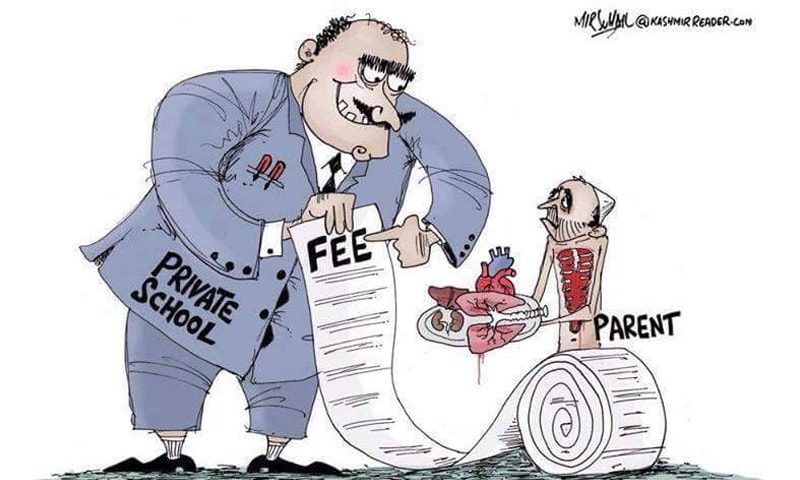What is the issue?
-
Regulating school fees is one of the most significant legal and political challenges policymakers in India face.
-
The issue of fee regulation finds itself at the intersection of constitutionally protected freedoms enjoyed by private schools and the need for making quality education affordable and accessible.
-
Over the years, the issue of skyrocketing tuition fees has confronted parents. Adding to their burden is the annual and steep hike in tuition fees along with additional costs such as fees for transport, extra-curricular activities and sports.
-
The managements of such schools claim that these hikes are reasonable and justified as the costs of maintaining a fully functional private school with quality teaching and world-class infrastructure are quite steep. In this context, balancing the autonomy of private schools and their public welfare function becomes a contentious issue.
Facts:
-
There are around 3,50,000 private unaided schools (24% of all schools) where 75 million children or 38% of all students, study.
-
Such schools do not receive any grant from government and have to generate their own revenue for sustenance.
-
In Mumbai and Delhi, for instance, arbitrary fee hike in such schools in last year varied between 10 % and 40 %.

So can private schools arbitrarily hike fees?
-
In M.A. Pai Foundation v. State of Karnataka(2002), the Supreme Court held that regulatory measures imposed on unaided private educational institutions must, in general, ensure the maintenance of proper academic standards, atmosphere and infrastructure and the prevention of mal-administration by the school management.
-
Subsequently, in Islamic Academy of Education and Anr. v. State of Karnataka and Ors(2003), a Constitution Bench of the Supreme Court held that these institutions have the autonomy to generate surplus which must be used for their betterment and growth.
-
While private schools are ‘entitled to a reasonable surplus for development of education and expansion of the institution, there has to be a balance between autonomy of such institutions and the measures taken to prevent commercialisation of education’.
-
However, there is not much clarity on what the terms “surplus”, “reasonable surplus” or “commercialisation of education” entail.
Weak laws
-
In order to prevent private schools from charging unreasonably high fees and to prevent misuse of funds, several State governments have either enacted fee regulation laws or are in the process of framing them.
-
States such as Tamil Nadu follow the fee fixation model whereby a government committee is empowered to verify and approve fee structures proposed by private schools.
-
Karnataka is for a formula that caps fees for schools by way of framing rules under its school education legislation.
-
Maharashtra has a weakly enforced legislation to regulate fees and has multiple government bodies to approve school fees. Recently, the Maharashtra government’s decision to cap proposed fee hikes at 15% was widely criticised by schools.
-
A recent order of the Gujarat High Court upholding the validity of the Gujarat Self Financed Schools (Regulation of Fees) Act, 2017 is now being reconsidered by the Supreme Court. The court has directed the government to not take any coercive steps against schools in the interim period.
-
As of now, these models are affected by the challenges of weak implementation, a lack of capacity and constant legal challenges posed by private school associations.
-
There is a larger irritant which is entrenched in the way private schools operate. In 2010, the Comptroller and Auditor General slammed 25 well-known private schools in Delhi for arbitrary fee hikes.
-
According to the report, money was being collected from parents under false heads, while at the same time, teachers were being underpaid, and accounts misrepresented.
-
Existing legislative efforts have made an incomplete assessment of the deeper problems with financial management and accounting practices adopted by private schools.
Accounting standards
-
The new wave of fee regulation laws being debated and enforced in States has the potential to address the problems Indian parents face.
-
However, there is still a lack of jurisprudential clarity on what private schools can or cannot do, how much “surplus” they can make, or what “commercialisation” actually means.
-
In order to make these laws more effective, the solution would be to address the disease of financial mismanagement and misreporting, and not the symptoms. In Modern School v. Union of India(2004), the Supreme Court recommended accounting standards for private schools.
-
Further, measures such as regular government supervised audits, generating capacity in State-level Departments of Education, regular inspections, and stricter sanctions for fraudulent reporting could be considered.
National Commission for Protection of Child Rights (NCPCR) Draft fee regulations:
-
Aim is to put in place uniform fee framework to check frequent and arbitrary increases in school fees by unaided private schools.
-
It proposes 10% yearly cap on the fee hike permissible by private, unaided schools.
-
It suggests setting up district fee regulatory authority in states to monitor school fee increases.
-
It suggests formula for determining fees, based on school’s location, costs incurred, revenue earned, student strength and other parameters.
-
It proposes fines on schools if they violates uniform fee framework. These schools will be fined 1% of revenue it generates for first instance of violation of these rules and it will increase to 2 % and 5% for second and third violation.
-
For any subsequent violation, it proposes to place school in no admission category and bar it from admitting new students.
-
Note: The regulation of education-related matters is domain of HRD ministry, but NCPCR has stepped in to draft fee regulations for unaided schools, citing Section 13 of Commission for Protection of Child Rights (CPCR) Act, 2005 and Section 32 of Right to Education (RTE) Act, which gives it authority to review safeguards under law to protect of child rights and recommend measures.
Source: